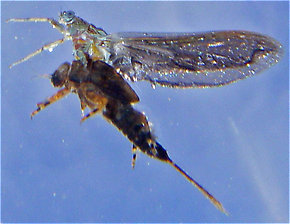Blog & Latest Updates
Fly Fishing Articles
Insects by Common Name


Mayfly Species Ephemerella subvaria (Hendrickson)
Taxonomic Navigation -?-
Kingdom
Animalia (Animals)
» Phylum
Arthropoda (Arthropods)
» Class
Insecta (Insects)
» Order
Ephemeroptera (Mayflies)
» Species subvaria (Hendrickson)
Common Names
The fame is well-deserved. Ephemerella subvaria is a prolific species which drives trout to gorge themselves. Its subtleties demand the best of us as anglers, and meeting the challenge pays off handsomely in bent graphite and screaming reels.
Where & When
This hatch marks the start of serious mayfly action on almost every major trout water in the East and Midwest in the early spring.
The emergence begins in early April in the trout streams of southern Pennsylvania. It peaks in mid-May in the Catskills and late May farther north. It can linger through early June in northern areas like the Upper Peninsula of Michigan.
Good action lasts from two to three weeks on any given river.
Hatching Behavior
Time Of Day (?): Afternoon, usually mid-afternoon, for about 1 hour
Habitat: Calm water with slow to medium current
Water Temperature: Most sources say 50-55�F, though Fred Arbona reports 55-65�F
Hendricksons emerge by crawling out of their nymphal skins in the surface film, and emerger patterns are ideal. The duns float for a long time before taking flight and they, too, can be important to imitate. The Hendrickson and Red Quill fly patterns were created to meet this demand in the early days of American fly fishing.Habitat: Calm water with slow to medium current
Water Temperature: Most sources say 50-55�F, though Fred Arbona reports 55-65�F
Spinner Behavior
Time Of Day: Late afternoon to evening; or, on cold evenings, delayed until 7-11:00 a.m. the next day
Habitat: Riffles and runs
Most sources say that the females drop their eggs from high above the water and become vulnerable to trout only when they fall spent (Spent: The wing position of many aquatic insects when they fall on the water after mating. The wings of both sides lay flat on the water. The word may be used to describe insects with their wings in that position, as well as the position itself.) with the males. These can be intense events, especially on warm days when the activity is compressed into a shorter time period, about 30 minutes, near dusk.Habitat: Riffles and runs
Knopp & Cormier in Mayflies: An Angler's Study of Trout Water Ephemeroptera contradict the more common story. They acknowledge that sometimes the females drop their eggs from on high, but they claim that Hendricksons more often fall to the water, not yet spent (Spent: The wing position of many aquatic insects when they fall on the water after mating. The wings of both sides lay flat on the water. The word may be used to describe insects with their wings in that position, as well as the position itself.), before releasing their eggs. They report that trout may be selective to spinners with upright, half-spent (Spent: The wing position of many aquatic insects when they fall on the water after mating. The wings of both sides lay flat on the water. The word may be used to describe insects with their wings in that position, as well as the position itself.), or spent (Spent: The wing position of many aquatic insects when they fall on the water after mating. The wings of both sides lay flat on the water. The word may be used to describe insects with their wings in that position, as well as the position itself.) wings. Some fly shops sell patterns with bright butts to imitate these egg-laden females.
Nymph Biology
Current Speed: Everything except extremely fast; they move to slower water near emergence time.
Substrate: Gravel, small boulders, vegetation. Swift gravelly runs are especially favored.
Environmental Tolerance: Among the least tolerant species in the Ephemerellidae. They require moderate temperatures, neither too hot nor spring-fresh cold, and they cannot tolerate pollution.
There is tremendous physical variation within this species, especially in the coloration of the nymphs. In Hatches II, Caucci and Nastasi describe six distinct variations on Hendrickson nymphs, and my collections show at least one more. The lesson is that the angler should study the nymphs from his own stream and carry varied imitations. Substrate: Gravel, small boulders, vegetation. Swift gravelly runs are especially favored.
Environmental Tolerance: Among the least tolerant species in the Ephemerellidae. They require moderate temperatures, neither too hot nor spring-fresh cold, and they cannot tolerate pollution.
The nymphs are very active and available to trout in the hours leading up to and during the hatch, and sometimes they negate the importance of the duns. This is especially likely on cold days, according to Knopp & Cormier, who recommend fishing a wiggle nymph under such circumstances. Several authors have observed that the nymphs swim with a strong wiggle when in slow water, but they sit back and dead drift in faster currents. Our fishing should reflect this.
Before the hatch, the nymphs repeatedly swim up and down from the surface in what seem like "practice runs" for emergence. Sometimes they do this days or even weeks before emerging; I have seen this behavior in northern Wisconsin on March 17th, over a month before the first emergence on the river.
Ephemerella subvaria Fly Fishing Tips
There are significant differences between the males and females in both size and color, and anglers should be prepared to match either one.
Wet or cloudy days are traditionally regarded as good Hendrickson weather, although I have fished them under a wide array of conditions, from snowstorms to warmth and sun. If you encounter them on especially damp or stormy days, you've got good reason to try fishing a cripple (Cripple: In fly fishing, a cripple is any insect which has been injured or deformed so that it cannot escape the water. This may include stillborn emergers or fully emerged adults which have been damaged, often by wind or waves, so that they can no longer fly. Trout often favor eating crippled insects.) pattern. A crippled Hendrickson dun imitation might work just as well on a calm, bright, spring day as on a stormy one, but that gives us one less excuse to feel clever about choosing to fish one.
Pictures of 34 Mayfly Specimens in the Species Ephemerella subvaria:
Male Ephemerella subvaria (Hendrickson) Mayfly Dun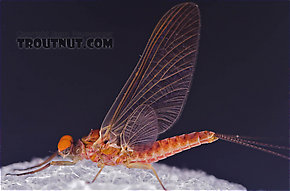 View 9 PicturesI collected this male Hendrickson dun and a female in the pool on the Beaverkill where the popular Hendrickson pattern was first created. He is descended from mayfly royalty.
View 9 PicturesI collected this male Hendrickson dun and a female in the pool on the Beaverkill where the popular Hendrickson pattern was first created. He is descended from mayfly royalty.
 View 9 PicturesI collected this male Hendrickson dun and a female in the pool on the Beaverkill where the popular Hendrickson pattern was first created. He is descended from mayfly royalty.
View 9 PicturesI collected this male Hendrickson dun and a female in the pool on the Beaverkill where the popular Hendrickson pattern was first created. He is descended from mayfly royalty.Collected April 19, 2006 from the Beaverkill River in New York
Added to Troutnut.com by Troutnut on April 22, 2006
Added to Troutnut.com by Troutnut on April 22, 2006
Male Ephemerella subvaria (Hendrickson) Mayfly Spinner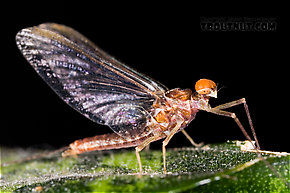 View 11 PicturesI collected this beautiful male Hendrickson specimen as a dun, along with a female Hendrickson from the same hatch. Both molted into spinners in my house within a couple of days.
View 11 PicturesI collected this beautiful male Hendrickson specimen as a dun, along with a female Hendrickson from the same hatch. Both molted into spinners in my house within a couple of days.
 View 11 PicturesI collected this beautiful male Hendrickson specimen as a dun, along with a female Hendrickson from the same hatch. Both molted into spinners in my house within a couple of days.
View 11 PicturesI collected this beautiful male Hendrickson specimen as a dun, along with a female Hendrickson from the same hatch. Both molted into spinners in my house within a couple of days.Collected April 23, 2007 from Fall Creek in New York
Added to Troutnut.com by Troutnut on April 25, 2007
Added to Troutnut.com by Troutnut on April 25, 2007
Ephemerella subvaria (Hendrickson) Mayfly Nymph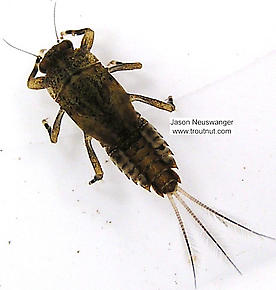 View 7 PicturesThis is another unusual brown Ephemerella nymph. The "fan-tail" which defines the Ephemerella genus is particularly evident on this specimen.
View 7 PicturesThis is another unusual brown Ephemerella nymph. The "fan-tail" which defines the Ephemerella genus is particularly evident on this specimen.
 View 7 PicturesThis is another unusual brown Ephemerella nymph. The "fan-tail" which defines the Ephemerella genus is particularly evident on this specimen.
View 7 PicturesThis is another unusual brown Ephemerella nymph. The "fan-tail" which defines the Ephemerella genus is particularly evident on this specimen.Collected February 7, 2004 from unknown in Wisconsin
Added to Troutnut.com by Troutnut on January 25, 2006
Added to Troutnut.com by Troutnut on January 25, 2006
24 Underwater Pictures of Ephemerella subvaria Mayflies:
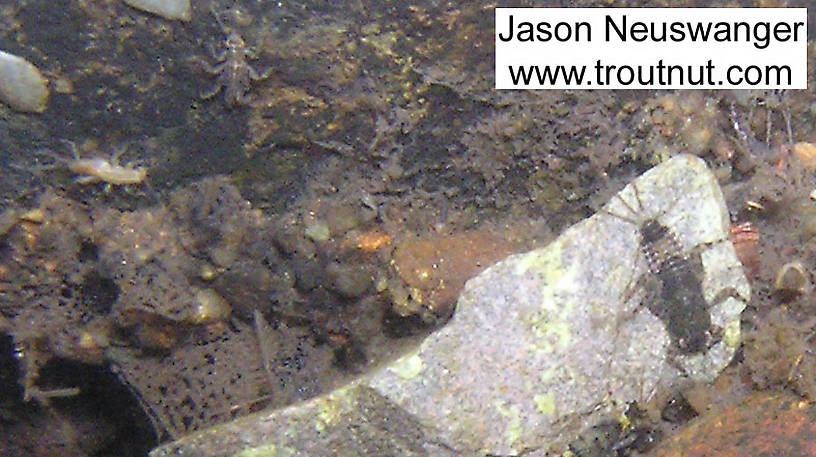
An Ephemerella subvaria nymph clings to a white rock in the foreground, and there are other nymphs in the background.
In this picture: Mayfly Species Ephemerella subvaria (Hendrickson) and Insect Order Trichoptera (Caddisflies).
In this picture: Mayfly Species Ephemerella subvaria (Hendrickson) and Insect Order Trichoptera (Caddisflies).
StateWisconsin
LocationNamekagon River
Date TakenMar 20, 2004
Date AddedJan 25, 2006
AuthorTroutnut
CameraOlympus C740UZ
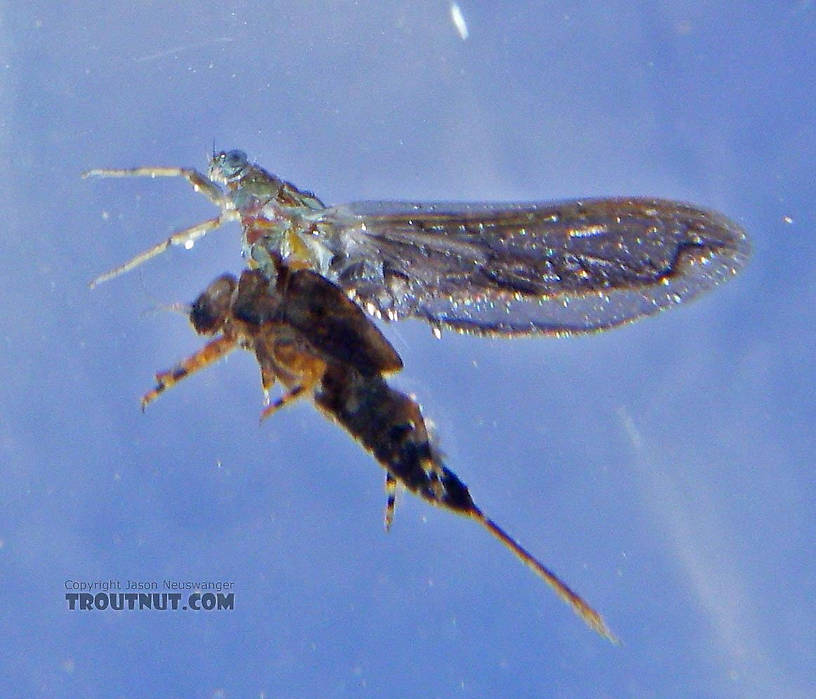
This is a close-up underwater view of a stillborn (Stillborn: In fly fishing, a stillborn insect is one which got stuck in its nymphal or pupal shuck during emergence and floats helplessly on the surface instead of flying away. It is a specific class of cripple, although it is sometimes used interchangeably with that term.) Ephemerella subvaria (Henrickson) female dun.
In this picture: Mayfly Species Ephemerella subvaria (Hendrickson).
In this picture: Mayfly Species Ephemerella subvaria (Hendrickson).
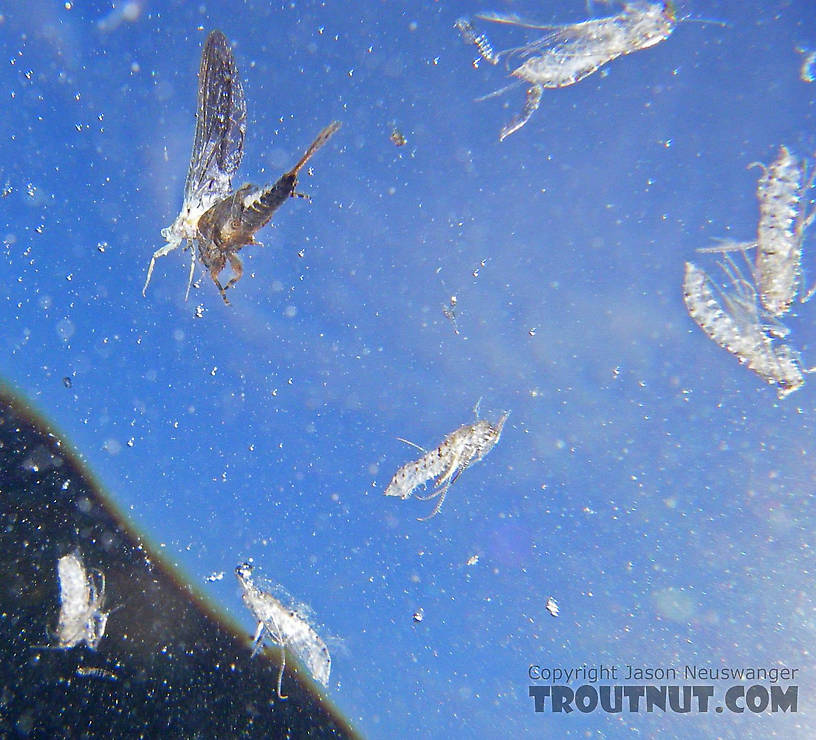
This picture from below shows a stillborn (Stillborn: In fly fishing, a stillborn insect is one which got stuck in its nymphal or pupal shuck during emergence and floats helplessly on the surface instead of flying away. It is a specific class of cripple, although it is sometimes used interchangeably with that term.) Ephemerella subvaria (Hendrickson) dun drifting on the surface amidst a number of shed pupal skins from Brachycentrus caddisflies which were heavily hatching that day.
In this picture: Caddisfly Species Brachycentrus appalachia (Apple Caddis) and Mayfly Species Ephemerella subvaria (Hendrickson).
In this picture: Caddisfly Species Brachycentrus appalachia (Apple Caddis) and Mayfly Species Ephemerella subvaria (Hendrickson).
Recent Discussions of Ephemerella subvaria
Hatching Hendrickson
Posted by Martinlf on Oct 14, 2008
Here's another hatching mayfly, this one stillborn. Click on "31 more specimens" and scroll down.
ReplyWhen does a Hatch happen? 8 Replies »Posted by TheMidge on May 10, 2007
Last reply on May 26, 2007 by Greenghost
I was hoping I could get a little info on what effects a Hatch. Air Temp? Water Temp? A combination? I'm trying to determine the best time to catch a hatch on stream near me, as I have a small window to fish in on a short trip home. I am expecting to see Hendrickson's, as it's the right time of year (or so I have been told) for this stream. What's the best way to guess?
Replyunderwater photos 4 Replies »Jason, thanks for the underwater photos of subvaria nymphs and the stillborn dun. Anyone looking at this thread may have to search for them a bit, (click on "There are 29 more specimens") but they are well worth the viewing! They have given me a better understanding of how to modify my upside down mayfly tie to better represent still born and crippled subvarias, and the underwater nymph pictures have confirmed my thoughts about coloration on flies designed to imitate subvaria nymphs. The photos are phenomenal, not like any bug photos I've seen before, in that they show the insects in a natural habitat.
ReplyYour Thoughts On Ephemerella subvaria:
Top 10 Fly Hatches
Top Gift Shop Designs
Eat mayflies.
Top Insect Specimens
Miscellaneous Sites
Troutnut.com is copyright © 2004-2024 Jason
Neuswanger (email Jason). See my FAQ for information about use of my images.
 privacy policy
privacy policy

